CELL THE BASIC UNIT OF LIFE
INTRODUCTION
All living organisms are made up of a variety of body parts like roots, leaves, flowers, fruits, wood etc. in plants and bones, flesh, nerves etc in animals. These parts look different from each other, yet they are all composed of tiny units called cells. Moreover, many living organisms like Amoeba, Paramecium, Chlamydomonas etc. consist of only one cell. (CELL – A UNIT OF LIFE)
DEFINITION
A cell is the structural and functional unit of all living beings. A cell is microscopic. In an organism cell is the minute part of a body. All living beings start their life as a single cell. Every cell has its own life span. (CELL – A UNIT OF LIFE)
CHARACTERISTICS ( CELL – A UNIT OF LIFE)
Old and worn-out cells are continuously replaced by new cells. It consists of an organized mass of protoplasm, surrounded by a selectively permeable covering called plasma membrane. In an animal cell, the plasma membrane is the only limiting membrane. However, in plant cells, fungi and bacteria, the cell is also surrounded by a cell wall. (CELL – A UNIT OF LIFE)
DISCOVERY OF CELL
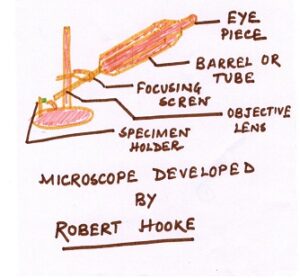
Fig#1 first microscope developed by Robert Hooke
The invention of microscope helped in the discovery of cell.
The first microscope was constructed by Anton Von Leeuwenhoek (1632 – 1723). It consist of a single biconvex lens and was known as the simple microscope. Some of the Leeuwenhoek’s microscopes could magnify objects up to 200 times.
Robert Hooke (1635 – 1703) developed a compound microscope by using two lenses for achieving greater magnification. Robert Hooke studied a thin slice of cork under his microscope. He observed that the cork slice had a large number of compartments as ” cells”. (in Latin: Cella means compartment).
CELL THEORY
The cell theory was formulated by two german biologists, Matthias Schleiden (1838) and Theodor Schwann (1839), their theory stated cell as the basic structural and
functional unit of all living beings.In 1855, Rudolf Vir Chow added a phrase ” omnis cellula-e- cellula”, meaning all cells arise from pre – existing cells.
Cell theory can be stated as follows:
* The structural and functional unit of all living beings is the cell.
* All living organisms are composed of cells ( CELL – A UNIT OF LIFE)
* All new cells arise as a result of division of pre – existing cells.
* All cells are chemically similar in composition and in biological process. (CELL – A UNIT OF LIFE)
SIZE OF THE CELL
The smallest known cell is Mycoplasma or pplo (Pleuropneumonia –like organism).
It’s size varies from 0. 1 to 0. 5micrometer. The bacterial cell is 0. 5 to 5 micrometre.
Human red blood corpuscles are 7 to 20 micrometre. ( cell)
Human liver and kidney cells are 20 to 30 micrometre. Nerve cells are about 90 to 100 cm in size which are the longest cell in world. Acetabularia is the longest plant cell having
a length of 10 cm which is a single-celled alga. The largest cells are the bird’s egg. The egg of an
Ostrich is 170x 135 mm which is the largest single cell. ( CELL – A UNIT OF LIFE)
Cell number: ( CELL – A UNIT OF LIFE)
Many organisms are made up only one cell or many cells.
Single-celled: Organisms are made up of only one cell, they are called Single-celled
or unicellular. For example, Bacteria, Amoeba Paramecium, Euglena Chlamydomonas ete.
Multicelled: Most organisms are multicellular
i.e. they are made up of several cells.A newly – born human baby has 2 trillion cells
while an adult man has about 100 trillion cells.
Cell – shape
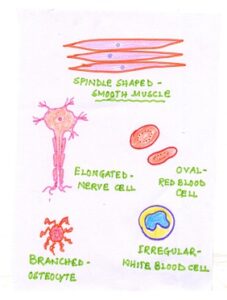
Fig#2 different shapes of cell
Cells show a great variation in their shapes to suit their functions. Most cells have a definite shape.Cells may be
Spinde – shaped – muscle cells
Elongated – nerve cells
Oval- red blood corpuscles
Branched – osteocytes
irregular shaped – white blood corpuscles
Type of cell
On the basis of their nuclear organizalioncells have been classified into two types
Prokaryotic cells:
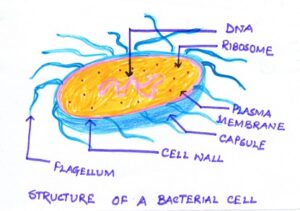
Fig#3 structure of a prokaryotic cell
[ pro – before; karvos – nucleus ]Prokaryotic cells having a primitive nucleus. The nuclear material in these cells is not enclosed by a nuclear membrane. These cells lack several cell organelles like mitochondria, lysosome, endoplasmic reticulum
chloroplast and nucleolus. Bacteria and blue–green algae are examples of prokaryotic cells.
Eukaryotic cell ( CELL – A UNIT OF LIFE)
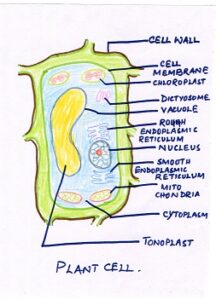
Fig#4 simplified structure of plant cell
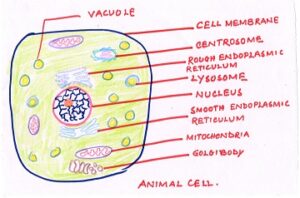
Fig#5 simplified structure of animal cell
[eu-true; karyon-nucleus] Eukaryotic cells mean cells having a properly defined nuclear membrane. In these cells , the genetic material is made of two or more DNA molecules which form chromatin fibres . The nuclear material is enclosed in a nuclear membrane. These cells have a well-organised nucleus and have well-developed membrane-bound organelles,such as mitochondria, endoplasmic reticulum, lysosome, chloroplast and nucleolus. Eukaryotic cells occur in plants, animals,fungi and protozoa. (cell)
AN OVERVIEW OF CELL ( CELL – A UNIT OF LIFE)
| CELL
ORGANELLE |
KEY
CHARACTERISTICS |
KEY
FUNCTION |
DIAGRAM |
| 1) Cell wall | a)Found only in plant cell
b)Composed of cellulose c)Rigid, protective, supportive in nature |
a)It provides shapes and rigidity to the cell
c)protects plasma membraneand internal structure of the cell |
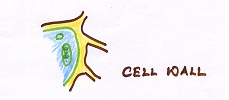 |
| 2)Plastid | a)Double-layered proteinaceous containing DNA
b)Three types of organelles:- Chloroplast, Chromoplast, Leucoplast c)Found only in plant cell |
a)Chloroplast helps in photosynthesis
b)chromoplast imparts colour to flower and fruit c)Leucoplast helps in the storage of food |
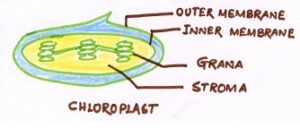 |
| 3)Centrosome | a)Found only in animal cell.
b)Small, naked, protoplasmic structure present near the nucleus. c)Consists of two small granules called centrioles. |
a) Initiates and regulates cell division.
b)Helps in cell division. |
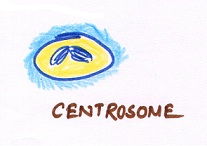 |
| 4)Cell membrane | a)Found in both the cells.
b)selectively permeable. c)Made up of lipids and proteins in the bilayer. |
a)Allows only selective substances to pass through it.
b)protects the cell from injury. |
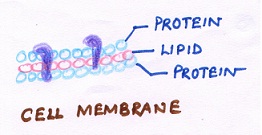 |
| 5)Cytoplasm | a)Amorphous, transluscent, colloidal liquid.
b)Contains inorganic molecules, water, organic compounds. |
a)Helps in exchange of material between different cells.
b)Biosynthesis of protein,fatty acid takes place. |
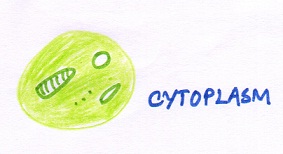 |
| 6)Endoplasmic reticulum | a)Interconnected system of membrane lined channels.
b)It may be rough for the presence of ribosome. |
a)Acts as skeletal framework of cell.
b)Helps in synthesis and transport of proteins and fats. |
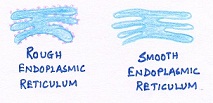 |
| 7)Ribosome | a)Small granules found either floating in cytoplasm or attached to the outer surface of rough endoplasmic reticulum.
b)Found in mitochondria and plastid. |
a)Helps iin protein sysnthesis. | 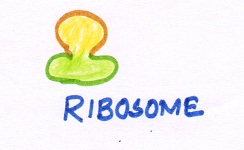 |
| 8)Mitochondria | a)sausage-shaped.
b)double-walled. ( CELL – A UNIT OF LIFE) c)Inner membrane given into folds. d)Matrix contains lipids, proteins,DNA,RNA. |
a)Oxidizes food to release energy in the form of ATP.
b)Synthesizes respiratory enzymes and many amino acids. |
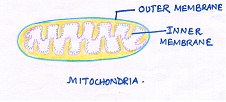 |
| 9)Golgi bodies ( in animal); Dictyosome (in plant) | a)Stacks of flattened sacs or cisternae.
b)Contains vesicles, vacuoles, tubules. |
a)Helps in secretion of mucus, enzymes and hormones.
b)Helps in storage. |
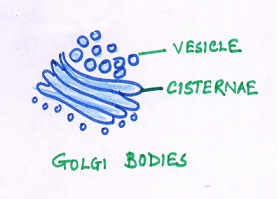 |
| 10)Lysosome | a)Membranous sacs budded off from Golgi bodies. ( CELL – A UNIT OF LIFE)
b)Having a resistant membrane. |
a)Helps in intracellular digestion.
b)Provides energy during starvation. |
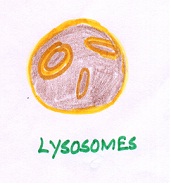 |
| 11)Nucleus | a)Dense, spherical, cylindrical body at the
centre. b)Contains chromatin which contains DNA. |
a) Helps in cell division.
b)Regulates all functions within cell. c)Possesses all genetic informations in gene. |
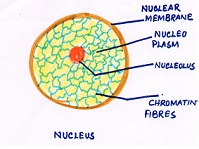 |
| 12)Vacuole | a)Fluid-filled membrane bound space.
b) Large in plant cell. c) Small in animal cell. |
a)Helps cell to remain turgid.
b)Helps in cell elongation. c)Helps in storage of water and other substances. |
 |